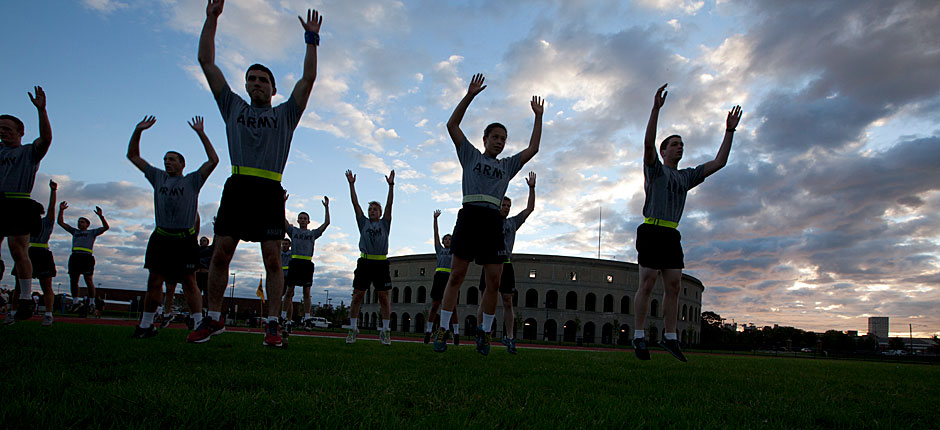Since Veteran’s Day word reached me, and perhaps many of you, that at least one respected member of the Harvard community used Veterans Day to express disgust at Harvard University for the following “facts”: That Harvard College does not have a military officer training program on campus, and that our cadets have to “go all the way to MIT” for their training. In addition to being a veteran, I am also a graduate of the US Army’s Reserve Officer Training Corps (ROTC). Consequently, I feel qualified to settle this matter.
Before I do, let me say that I am no apologist. In the past, the Harvard community did indeed fail the ROTC cadets on our campus. Young men were heckled, and worse, simply because they had chosen to make a commitment of service to our nation. Our community was – of course – venting its rage about the Vietnam War like so many other communities were at the time, but it is particularly sad that a university which gathers unto itself the most brilliant minds on the planet would not be sufficiently able to redirect those minds onto the appropriate target for their rage. After all, Harvard’s cadets were not the decision-makers sending American troops to kill and be killed in Southeast Asia.
That said, Harvard is not now the same place that it was in the 1970s. Thirty-seven years ago, the Army had to withdraw ROTC from our campus. But last year – on March 28, 2012, to be exact – Harvard welcomed Army ROTC back. Navy ROTC had actually returned a year earlier. And by “returned” I don’t just mean that the College allows its undergraduates to attend ROTC courses for credit at MIT. There are actually offices of the ROTC programs here in our midst (near Radcliffe Yard, in the case of Army ROTC), and cadets can be seen exercising at Soldiers Field on certain weekend mornings. So much for the College not having ROTC.
And what about this idea of going “all the way to MIT”? Anyone who thus lamented is woefully uninformed about the present state of military officer training in our country. The Army’ says that ROTC is “available at over 1,100 colleges and universities nationwide.” Some may jump to the conclusion that most of those schools therefore have self-contained ROTC programs. This is false. The vast majority are “satellite” schools, meaning they are affiliated with another school’s ROTC program, sending cadets and receiving certain reciprocal support. The reason for this system is simply its cost. It is far more affordable for the U.S. government to establish, sustain, and administer a relatively small number of regional ROTC units as opposed to having separate cadres at schools which in some cases (Harvard/MIT) are practically a stone’s throw apart. Boston has three ROTC units serving dozens of institutions. Imagine the change to the military’s budget if every one of Boston’s colleges and universities had its own ROTC unit.
What does this mean practically for the cadets? Honestly, it depends. Every ROTC unit works with each school’s administration to determine what a satellite school receives from its servicing ROTC unit. In the case of Lafayette College, a satellite of my old ROTC unit at Lehigh University, the school provides office and classroom space, and the ROTC unit sends a cadre member a few times per week to conduct physical training and classroom instruction. Other schools essentially provide nothing but course credit for the ROTC cadets, who have to receive everything they need to complete ROTC training at a location removed from their campus. Harvard falls somewhere in the middle.
We should also be realistic about what it means to go “all the way” to MIT. One may walk from Harvard to Kendall Square (on the far side of MIT’s campus) in about 40 minutes. Bike, bus, and subway are all much faster. The distance, being about two miles from our Yard to the MIT ROTC building, is much shorter than many travel requirements for cadets at other schools, like the Lafayette College cadet’s nine-mile one-way commute to Lehigh, for which the only possible mode is the automobile (intercity bus and other modes being nonexistent in the Lehigh Valley). By comparison, Harvard cadets have it pretty good. There is clearly a certain amount of relativity in the critique of commuting distance.
While the Harvard community is well served by healthy skepticism and examination of the operations and maintenance of our university, we must always be vigilant to ensure the outspoken are speaking in alignment with the facts. Recent comments against Harvard’s ROTC program are plainly counterfactual. Let’s be mindful of the steps forward Harvard has taken in recent years. Let’s not worry about contrived criticisms which aren’t borne out by the facts.

